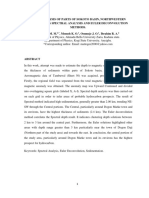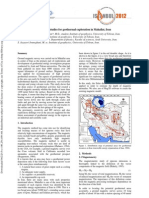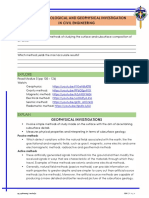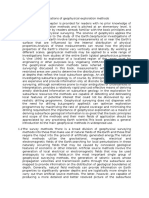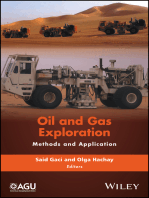Research Session Template ICAST 2015
Research Session Template ICAST 2015
Uploaded by
Triswan MardaniCopyright:
Available Formats
Research Session Template ICAST 2015
Research Session Template ICAST 2015
Uploaded by
Triswan MardaniOriginal Description:
Original Title
Copyright
Available Formats
Share this document
Did you find this document useful?
Is this content inappropriate?
Copyright:
Available Formats
Research Session Template ICAST 2015
Research Session Template ICAST 2015
Uploaded by
Triswan MardaniCopyright:
Available Formats
Study of Geomagnetic Method for Mapping Buried Pipes In
ITS Campus Area
Triswan Mardani Ade Surya*, Yulia Nur Fajrina, Dr. Dwa Desa Warnana
(Note: * should be placed at the presenters name as shown above.)
Abstract- Magnetic survey is purpose to investigate a geology
subsurface which based on anomalies in the earth's magnetic field as
a result from the magnetic properties of the underlying rocks.
Anomalies in the earth's magnetic field are caused by induced or
remanent magnetism. Induced magnetic anomalies are the result of
secondary magnetization induced in a ferrous body by the earths
magnetic field. The geomagnetic method involves the measurement
of the earth's magnetic field intensity and generally the total magnetic
field is measured. For searching buried things at the subsurface
typically used to locate abandoned steel well casings, buried tanks,
pipes and metallic debris. The depth parameters for its buried things
would become important to proven for analyze the spreading. The
purpose of this study is to map and prove the geometry and position
of buried pipes in ITS campus area. In this study, for measurement of
geomagnetic survey used 5 meters for space between a point and
some variation of measurements used 3 meters for space to show the
grid influenced of geomagnetic anomaly. The Diurnal Correction,
Upward Continuation Multi-elevation, and Reduction to Pole
Correction will be applied for the data. A magnetic contour map will
be used for qualitative interpretation and Inversion Method will be
used for quantitative interpretation. The result of this study is
magnetic anomaly as a function of the orientation, geometry, depth,
and magnetic susceptibility of the body as well as the intensity and
inclination of the earth's magnetic field in the survey area. The body
which would become an interpretation target is the spreading of
buried pipes depth and position in ITS campus area.
Index Terms- Buried Pipes, Geomagnetic Method, Depth and
orientation of magnetic body, ITS campus
I. INTRODUCTION
Magnetic surveys occasionally have been used by geophysicist and
geologists to locate changes in rock type such as might be associated
with ore bodies, fault contacts, or igneous rocks Another common
application is determining the probable depth to basement beneath
sedimentary rocks. For these applications, the principal geologic
variable is the distribution of ferromagnetic minerals, mainly
magnetite, within the earth. The theory and survey procedures are
described in a variety of references
Usually magnetic surveys are used in hazardous waste site
investigations to locate gallon drums, underground storage tanks,
buried pipes, and the edges of covered landfills. These applications
usually involve shallow iron or steel objects, which influence the way
the surveys should be conducted and interpreted.
Based on problem which found, some buried pipe in ITS Campus
Surabaya could be hazardous waste and could disturb to build the
development facilities. Maps which contain depth parameters for its
buried things would become important to proven for analyze the
spreading. So the purpose of this study is to map and prove the
geometry and position of buried pipes in for investigation of
hazardous waste and also for complete the master plan data for
development plan.ITS campus area. This research is very useful
II. LITERATURE REVIEW
Geomagnetic Methods (magnetic method) is a geophysical
method often used as a preliminary survey on exploration of
mineral rocks such gold minerals. Accuracy of measurement
methods. The relatively high magnetic and operation field is
relatively simple, easy and fast In general, the field anomaly
map Magnetic is somewhat complex, variation the terrain is
more erratic and localized as a result of the dipole magnetic
field which is a vector quantity. Map anomaly magnetic
showed a large number of residual anomaly is the result of a
variation magnetic minerals contained in rocks near the
surface.
Basic of geomagnetic method came from magnetic material
is placed in the external field H will produce a field separate
H' which enhances the value of total the material's magnetic
field. Induction the magnetic field is defined as Total material
written as:
(1)
Relations secondary field unit B in cgs is gauss, whereas in
exploration geophysics used unit gamma (g) and in SI is tesla
(T) or nanotesla (nT).
External Field (H) is define by magnetic field Strength at a
point within r of m1 is defined as force each magnetic poles
strength, can written as:
(2)
Where r is the distance from the measurement point m. H
has unit A / m in SI where as in cgs H have unit Oersted.
The level of a magnetic object to afford the magnetization is
determined by the susceptibility (k) magnetism, which is
written as:
I = kH
(3)
This quantity is the basic parameter used in the magnetic
method. The value of k on the rocks is even greater if are
composed by minerals that has natural magnetic properties.
In nature intensity of the magnetic field measured at top of
the surface of Earth is always changes with time. Magnetic
Field changes can happen in time relatively short or long. In
long period called secular variation which causes by variation
of field earth derived from variations often main magnetic
earth, as a result of changes in position of earth magnetic pole
and short period called daily variation which caused by
external magnetic field comes from rotation of the electric
current in the layer ionosphere the sourced come from particle
ionized by radiation sun the result current fluctuations that can
be the source of the magnetic field.
III.
RESEARCH
METHODOLOGY
Based on fig.2a we can determine location that indicate
have iron pipe or magnetic object buried below the surface by
looking at peak and low magnetic anomaly. If there are peak
and low magnetic anomaly are paired like a-a and b-b in
fig.2a that location could indicate have magnetic object or iron
pipe are buried below the surface. In order to interpret exact
location are buried we use inversion technique. This technique
is assumed the subsurface is arranged by tiny box, this tiny
box have different susceptibility value. This susceptibility
value is sum vertically then get calculate total field.
Fig.1 Diagram of methodology
The methodology for this research was explained in the
following diagram above. Before geomagnetic survey was
done, knowledge about geological setting and environment
condition must be applied for the acquisition plan &
understanding the result. Measurement of geomagnetic survey
used 5 meters for space between a point and some variation of
measurements used 3 meters for space to show the grid
influenced of geomagnetic anomaly. The Diurnal Correction,
IGRF Correction, Upward Continuation Correction will be
applied for the data. A magnetic contour map will be used for
qualitative interpretation and Inversion Method will be used
for quantitative interpretation. The result of this study is
magnetic anomaly as a function of the orientation, geometry,
depth, and magnetic susceptibility of the body as well as the
intensity and inclination of the earth's magnetic field in the
survey area.
IV. RESULT
Fig. 3 a Slicing Profile a-a, 3b subsurface susceptibility value based on
inversion technique
Fig. 3a showing the sliced anomaly value a-a line by blue
line and red line showing total field by inversion result. Fig.3a
showing misfit between total field measurement and total field
inverted result this misfit coming from limitation of
computational process in subsurface susceptibility modelling
and might be noises coming from measurement data that
complicate inversion process to get most suitable inversion
result. In this study a-a anomaly is taken based on field
survey that showing there are buried pipe on this location and
to easier validate inversion model that we create. Fig. 3b
showing inverted magnetic anomaly. In fig. 3b the iron pipe is
showed by highest susceptibility 0.35, this because iron pipe
has natural magnetic properties. Based on inversion result we
can conclude the iron pipe buried about 0.6 1 m below the
surface
V. ACKNOWLEDGMENT
The authors very thankful to Dr. Dwa Desa Warnana for
guidance and comment on this work and geophysical
engineering student for sharing magnetic data.
Fig. 2 Filtered geomagnetic data using upward continuation filter (a) residual
magnetic anomaly (b) Regional magnetic anomaly
The result of measurement magnetic data is show in to
contour map after corrected by diurnal correction then filtered
using upward continuation filter to remove regional anomaly
and showing magnetic local anomaly can be seen in fig. 2. the
map showing magnetic anomalies in ITS campus. Magnetic
data above (fig. 2a) giving us information about shallow
magnetic anomaly below the. This magnetic anomaly may
contain magnetic anomaly that generate by iron pipe that
estimated buried about 1 1.5 m.
VI. REFERENCES
[1]
[2]
[3]
[4]
Alam, C.W. R. N, 2013 Aplikasi Metode Geomagnetik Untuk
Identifikasi Batuan Beku Dasit di Bukit Siwareng Kabupaten Sleman
Daerah Istimewa Yogyakarta, Jurusan Teknik Geofisika, Universitas
Pembangunan Nasional Veteran Yogyakarta.
Barrows, L. and Judith E. R., 1990, Magnetic Surveying for Buried
Metallic Objects, Reprinted from the Summer 1990 Issue of Ground
Water Monitoring Review, USA.
Pratama, Y. A., 2015, Akuisisi Magnetik dan Pengolahan dalam Skala
Laboratorium Menggunakan Aplikasi AndroidMagnetic Field
Detector, Geomagnetic Laboratorium, UPN Veteran Yogyakarta.
Telford, W.N., Geldard, L.P., Sherrif, R.E., and Keys, D.A., 1976,
Applied Geophysics, Cambridge University Press, Cambridge, London,
Newyork Melbourne.
You might also like
- Hazard and Operability (HAZOP) & Hazard Analysis Training100% (10)Hazard and Operability (HAZOP) & Hazard Analysis Training106 pages
- Abundance of Isotopes: Name - Chem Worksheet 4-3No ratings yetAbundance of Isotopes: Name - Chem Worksheet 4-31 page
- Unit-III: Geophysical Methods of Mineral ExplorationNo ratings yetUnit-III: Geophysical Methods of Mineral Exploration40 pages
- Geophysical Evaluation of Magnetic Data of Okenugbo Area, Ago - Iwoye, Southwestern, NigeriaNo ratings yetGeophysical Evaluation of Magnetic Data of Okenugbo Area, Ago - Iwoye, Southwestern, Nigeria8 pages
- Aero-Magnetic Data Processing and InterpretationNo ratings yetAero-Magnetic Data Processing and Interpretation68 pages
- Mineral Prospecting Mine Surveying MNE101No ratings yetMineral Prospecting Mine Surveying MNE1018 pages
- Mapping of Gold Mineralization Using 3D InversionNo ratings yetMapping of Gold Mineralization Using 3D Inversion7 pages
- Depth Analysis of Parts of Sokoto Basin, Northwestern Nigeria Using Spectral Analysis and Euler Deconvolution MethodsNo ratings yetDepth Analysis of Parts of Sokoto Basin, Northwestern Nigeria Using Spectral Analysis and Euler Deconvolution Methods15 pages
- Surface Interpretation Based On Total Magnetic Anomaly Data in BUPERTA, CibuburNo ratings yetSurface Interpretation Based On Total Magnetic Anomaly Data in BUPERTA, Cibubur4 pages
- Geophysical Methods: Presentation/LectureNo ratings yetGeophysical Methods: Presentation/Lecture53 pages
- Magnetic Studies For Geothermal Exploration in Mahallat, IranNo ratings yetMagnetic Studies For Geothermal Exploration in Mahallat, Iran4 pages
- Magnetic Surveying For Buried Metallic Objects100% (4)Magnetic Surveying For Buried Metallic Objects8 pages
- General Introduction To Airborne Magnetic Survey100% (1)General Introduction To Airborne Magnetic Survey15 pages
- Geophysical Exploration and InterpretationNo ratings yetGeophysical Exploration and Interpretation73 pages
- Application of Magnetic Method in Grouundwater ExplorationNo ratings yetApplication of Magnetic Method in Grouundwater Exploration4 pages
- Estimating The Influence of Geomagnetic Disturbances On The Trajectory of The Directional Drilling of Deep Wells in The Arctic RegionNo ratings yetEstimating The Influence of Geomagnetic Disturbances On The Trajectory of The Directional Drilling of Deep Wells in The Arctic Region12 pages
- Magnetic Surveys: Geology 351 - Geophysical Methods For Geology, Engineering and Environmental Sciences (ATH)No ratings yetMagnetic Surveys: Geology 351 - Geophysical Methods For Geology, Engineering and Environmental Sciences (ATH)8 pages
- Exploration For Hydrocarbons in Offshore EnvironmentNo ratings yetExploration For Hydrocarbons in Offshore Environment25 pages
- Magnetometer Characterization of Iron orNo ratings yetMagnetometer Characterization of Iron or4 pages
- Geology Department: Shri J.N.P.G. College (K.K.C.) LucknowNo ratings yetGeology Department: Shri J.N.P.G. College (K.K.C.) Lucknow21 pages
- 10 Remote Sensing, Geophysics and PetrophysicsNo ratings yet10 Remote Sensing, Geophysics and Petrophysics11 pages
- Cordell, L & Grauch, VJS (1982) Mapping Basement Magn Zones From Aeromag Data in San Juan Vasin, NMNo ratings yetCordell, L & Grauch, VJS (1982) Mapping Basement Magn Zones From Aeromag Data in San Juan Vasin, NM2 pages
- Assignment 1 - Malvin Nabhan Kinty 101216118No ratings yetAssignment 1 - Malvin Nabhan Kinty 1012161185 pages
- The Principles and Limitations of Geophysical Exploration Methods100% (2)The Principles and Limitations of Geophysical Exploration Methods6 pages
- Oil and Gas Exploration: Methods and ApplicationFrom EverandOil and Gas Exploration: Methods and ApplicationSaid GaciNo ratings yet
- Digital Filtering in Seismic Data Processing inNo ratings yetDigital Filtering in Seismic Data Processing in7 pages
- 21 - 48 - 39-Petrel Printing - Interpretation Window 2 (TWT) - Original - Seismic - Seismic Time 1 - Inline 425No ratings yet21 - 48 - 39-Petrel Printing - Interpretation Window 2 (TWT) - Original - Seismic - Seismic Time 1 - Inline 4251 page
- .Join Interpretation Geophysics Method (Magnetotelluric, Gravity, Magnetic) in Arjuno-Welirang Geothermal FieldNo ratings yet.Join Interpretation Geophysics Method (Magnetotelluric, Gravity, Magnetic) in Arjuno-Welirang Geothermal Field1 page
- 2017 EME2066, Chap.1 Lecture Slides PDFNo ratings yet2017 EME2066, Chap.1 Lecture Slides PDF40 pages
- Flux Heated and Glass Filled Rubies From MozambiqueNo ratings yetFlux Heated and Glass Filled Rubies From Mozambique18 pages
- Geometrical Tolerancing On Technical Drawings: IS: 8000 (Part IV) - 1976No ratings yetGeometrical Tolerancing On Technical Drawings: IS: 8000 (Part IV) - 19767 pages
- Chemicals Zetag DATA LDP Zetag 7879 - 0410No ratings yetChemicals Zetag DATA LDP Zetag 7879 - 04102 pages
- Unit I Introduction To Differential EquationsNo ratings yetUnit I Introduction To Differential Equations23 pages
- Strength of Materials - II Question Bank PDFNo ratings yetStrength of Materials - II Question Bank PDF11 pages
- Computational Analysis of Randomness in Structural Mechanics Christian Bucher100% (2)Computational Analysis of Randomness in Structural Mechanics Christian Bucher252 pages
- P&Id Symbols: ISA Symbols and Loop DiagramsNo ratings yetP&Id Symbols: ISA Symbols and Loop Diagrams12 pages
- STANTON - Rotational Limits For Elastomeric BearingsNo ratings yetSTANTON - Rotational Limits For Elastomeric Bearings21 pages
- Phys 102 Recitation Problem Set 1: Chapter 21No ratings yetPhys 102 Recitation Problem Set 1: Chapter 213 pages
























